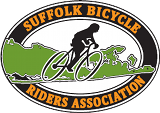Catch a Draft
The best way to learn good drafting technique is to pair up with an experienced rider. So if you're an old hand, help a new rider learn. If you're a newbie, find a veteran who's willing to help.
In this "how to" example, we'll assume you're the rookie.
Ride at a moderate pace on a low-traffic road. Put your front wheel about 3 feet (1 m) behind your guru's rear wheel. As you feel comfortable and confident, get a bit closer -- 2 feet, then 18 inches.
Twelve inches (30 cm) is close enough for recreational riding. You don't want wheels to touch, which usually causes a fall. Keep a safe margin so you can relax and look up the road, not focus nervously on a tiny gap.
Notice how the draft is stronger when you're closer, weaker as you drift back. Notice how you feel more benefit when speed increases.
Feel how the draft moves slightly to the side in a crosswind. Protection increases to the right of your partner's wheel when the wind is from the left, and vice versa.
Good drafting depends on smooth, even pedaling. If you pedal and coast, pedal and coast, you'll find yourself getting too close to your partner or too far back. Keep the crank turning and use slightly more or less pedaling force to maintain a constant gap.
Next, practice rotating the lead.
The front rider checks over her shoulder for traffic, flicks her elbow to alert you, then smoothly moves a couple of feet to one side -- into the crosswind or depending on road conditions or traffic -- and slows slightly by turning the crank without applying power ("soft pedaling").
You take the lead not by accelerating but by keeping your speed constant as your partner slows. Pedaling will feel a bit harder because you're bucking the wind. Glance at your cyclecomputer to make sure your speed stays steady.
Stay close as you pass each other while rotating the lead. The closer your shoulders are, the less wind each of you will be pushing and the narrower your combined width. That's important so motorists can deal safely with your presence.
When you're the person dropping back, begin accelerating slightly when your front wheel is beside your partner's rear wheel. Then you can slip in behind before a gap opens and you have to waste energy catching up.
**roadbikerider 6/17/10


